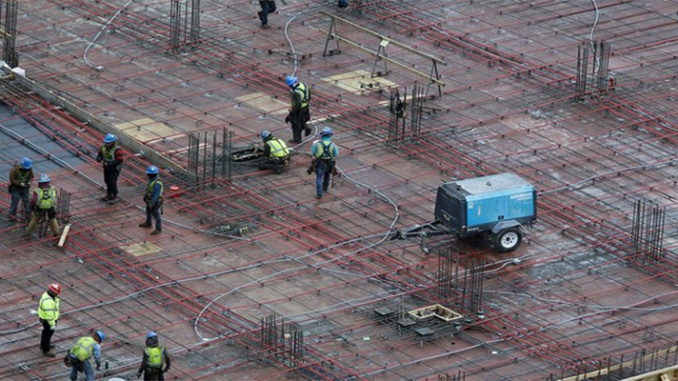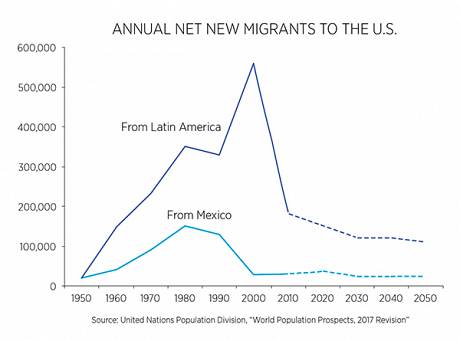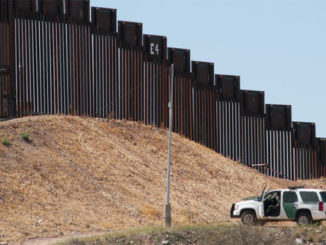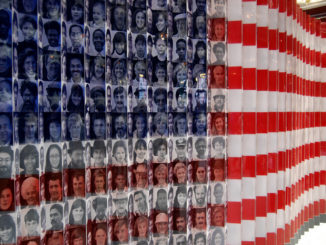
by Jack Goldstone
Without young workers, the economy can’t grow.
In times of economic trouble—and with gross domestic product (GDP) growth still below 2 percent in the United States, today surely qualifies—many Americans instinctively become more cautious about immigration. If we let in more workers, they fret, the newcomers will be a drain on the economy, dragging down wages and gobbling up services.

fact, precisely the opposite is true. The National Academy of Sciences recently released a comprehensive report finding that immigration has an overall positive impact on economic growth. Moreover, while new immigrants may have a slight depressing effect on the wages of prior immigrants, they have small to no effects on wages and employment for the native-born population.
If we want our economy to grow, what America needs more than anything is workers. Domestic fertility rates are plummeting even as the boomers are rushing into retirement. The U.S. birth rate hit an all-time low in 2017: 1.7 children per woman, well below the “replacement rate” of 2.1. At the same time, the number of immigrants entering the country has slowed considerably, thanks in part to the Great Recession of 2007–09. Not only do these trends put enormous pressure on the country’s entitlement system, they are already causing a drag on the economy. And this problem will only get more serious in the decades to come. Unless the U.S. finds a way to welcome more foreigners, and quickly, it is headed for a demographic crisis.
The concerns are understandable—but if we use them to justify constricting immigration, we’ll be doing a devastating disservice, not just to outsiders who want to start a life here, but to those of us who are already here.
The Changing Character of America’s Immigration
Anti-immigration politicians and activists often paint a picture of America as a place where immigrants are pouring across our southern border, where the overall number of outsiders is exploding, and where illegals dominate the foreign-born population. The reality couldn’t look more different. As fertility rates have crept downward in Mexico and Latin America, far fewer young people have been trying to enter the United States.
It’s true that since the 1965 Immigration and Nationality Act began allowing family unification, the number of foreign-born people in the country has greatly expanded. As a share of the U.S. population, it rose from 4.7 percent in 1970 to over 13 percent in 2015. That is higher than it has been at any time since the early 20th century, when immigrants reached almost 15 percent. In 2015, more than a quarter of all immigrants living in the U.S. were of Mexican origin, four times as many as from any other country.

Yet the total volume of new immigrants has fallen off in the last few years. In the two decades from 1980 to 2000, the share of foreign-born residents in the U.S. nearly doubled, from 6.2 percent to 11.1 percent. In the next decade and a half, from 2000 to 2015, it rose only from 11.1 percent to 13.4 percent.
Far from being out of control, the number of net new migrants to the U.S. has been falling. Out of a U.S. population that totaled 323 million in 2016, the annual increase in the foreign-born population from 2000 to 2010 was only 878 thousand per year. And that dropped to 648,000 per year, or about two-tenths of a percent of U.S. population, from 2010 to 2015.
Today, Latin America contributes little to U.S. immigration. Since 2009, more Mexicans living here have returned to that country than new Mexican immigrants have arrived. Although migration to the U.S. from the smaller Central American states has increased, the overall fraction of immigrants arriving who are Hispanic has dropped from more than half in 2001 to just over one-quarter in 2015. Asians, coming mainly from China, India, and Pakistan, now far exceed Hispanics among new immigrants.
Finally, it’s important to observe that the vast majority (76 percent) of immigrants in the country are legal. Of 44.7 million foreign-born residents of the United States, only about 11 million are unauthorized; 19.8 million have become naturalized citizens, 11.9 million are legal permanent residents, and 2 million are here on valid temporary (student or work) visas. Moreover, the reverse flow of Mexican migrants in the aftermath of the Great Recession means that the total number of illegals in the U.S. has recently dropped. After hitting about 12.2 million in 2007, it has been holding steady at 11 million for the last seven years.
The Incredible Shrinking Labor Force
If this strikes you as good news, think again. For an economy to grow, the average worker must produce more output over time and/or more workers must be employed in productive jobs over time. Since 2005, U.S. labor productivity (that is, real GDP per employed worker) has grown slowly if at all, averaging under 1 percent per year and even turning negative in 2016. The number of employed workers, meanwhile, has also been rising by just 1 percent per year. As a result, real GDP growth, somewhat disappointingly, has remained stuck at around 2 percent per year, rather than the 3–4 percent typical from 1960 to 2000.
America’s working-age population is about to put a further brake on that expansion. The baby boomers are retiring, and while the millennials—now the largest living generation—are entering the labor force, the cohorts coming up behind them are getting smaller. In 2015, the population of 15- to 24-year-olds in the U.S. was 44.2 million. That’s twice what it was in 1955. Yet in 2050, even assuming immigration increases to 1 million per year, that age group will be about 46.4 million, or just 5 percent higher. The strong growth in the number of young people entering the U.S. labor market essentially ended three years ago.

If not for immigrants and the children of immigrants, the size of the American labor force (that is, residents between 25 and 64) would decline over the next 20 years. From 2015 to 2035, the number of working-age Americans who are U.S.-born and who have U.S.-born parents will fall by 8 million workers. Without an influx of foreigners, we’re in for a bad time: Even if the rate of productivity growth doubled overnight, real GDP growth would be less than 1.6 percent per year.
We currently expect to gain, on net, 18 million immigrants in the next two decades. Assuming that’s correct, the total workforce will still grow by only 0.3 percent per year, thanks to retirements. Again, even if the productivity growth rate doubles, the small increase in the labor force will limit real GDP growth to less than 2 percent per year during that span.
Far from overwhelming the U.S. economy, Hispanic immigration is being lost as a driver of the economy. Before the recession of 2007, the U.S. Census Bureau predicted that the country’s population would reach 439 million by 2050. By contrast, the latest forecast, issued in 2017, is that U.S. population will reach only 388 million by that date—a difference of 51 million people. That means fewer workers and fewer taxpayers.
Where did those 51 million people go? They’re the immigrants and children of immigrants, mostly Hispanic, who would have materialized if immigration rates had continued as they were in the lead-up to 2007. But as we have noted, immigration has dropped sharply. Even more important, the fertility of Hispanics within the U.S. has also dropped by about a quarter since 2007.
As the Hispanic population becomes more like the native population in terms of education and employment, it also comes to resemble the rest of the population in terms of fertility. In the 1990s, Hispanic women in the United States had almost twice as many children as non-Hispanic whites. By 2016, the number was only 20 percent higher—70.6 births per 1,000 Hispanic women between 15 and 34, compared to 58.8 for non-Hispanic white women of the same age range.
Aging Populations Are Expensive
While immigration rates have declined and the growth in the working-age population has slowed to a crawl, elderly Americans are the demographic sector that is truly exploding. The number of people aged 65 and older in the United States is projected to grow from 49 million to 80 million by 2040, an annual rate of increase of 2 percent. The costs of providing pensions and health care for this group will rise at least as quickly as their numbers, but likely even more, as health care costs continue to go up faster than inflation.

Earlier, we allowed the rate of worker productivity to double overnight so projected GDP growth could remain at 2 percent per year. Yet that estimate assumed immigration would continue at current rates, providing 18 million new U.S. residents from 2015 to 2035. And despite our allowance, productivity growth is not likely to double. More realistically, it would do well to rise from 0.8 percent to 1.2 percent per year, resulting in annual GDP growth of 1.5 percent. While technology will continue to improve, the workforce is getting older. The number of young workers is going to be virtually flat for the foreseeable future, and workers over 40, whose productivity is usually stable or declining, will provide the bulk of the increase in the labor force. This means that the population of nonworking seniors is likely to grow faster—and the cost of their health care is likely to grow much faster—than GDP will.
The current rate of growth puts the United States squarely on track to exhaust the Social Security and Medicare trust funds in less than two decades. The best hope for stimulating faster growth to prevent this fiscal meltdown is to add more workers. To simply restore the U.S. population in 2050 to where we expected it to be a decade ago, America would have to admit at least an additional 1 million immigrants per year from now until then, for a total of 53 million over that period. This would raise the foreign-born population of the United States to 26 percent. If that seems like an intolerably high number, observe that it’s less than Australia has today.
It is also the price of America’s success in extending the life spans of its seniors and in enabling women to gain education and enter more professions. These achievements, while wonderful in their own right, have helped create the current problem: too few young workers and many more people surviving long years after retirement.
Beggars Can’t Be Choosers (and Shouldn’t Want To Be)
From 2010 to 2040, just two regions of the world are likely to enjoy increasing labor forces: India and Africa. After 2040, sub-Saharan Africa is projected to become the only region in the world with a growing workforce.
This is where many of our workers will need to come from. Imposing extra barriers on people from regions that are seen as “undesirable” is therefore a catastrophically bad idea. But it’s also a mistake to create strong preferences for skilled as opposed to unskilled migrants.
Anticipating a future driven by robots and artificial intelligence, some may think there is no point worrying about America’s future labor needs; the problem will be too many workers rather than too few. And some jobs may indeed disappear, such as taxi drivers, production line workers, and cashiers. Yet skilled workers—whether with craft skills in carpentry, masonry, or plumbing; with advanced technical skills such as writing computer code or welding complex alloys; with human skills such as caring for the elderly, troubled youth, children, or those with disabilities; or with creative skills in the arts, literature, or basic science, not to mention the professions of law, medicine, teaching, and religious ministries—will remain essential to the growth and functioning of modern economies. Robots are not likely to replace workers in these fields within the next two or three decades, while the growth of America’s young labor force has ended right now.
But unskilled immigrants too will be vital—for elder care (much of which is labor intensive), for craft and construction work, for landscaping and maintenance work, and for service work in the hospitality and tourism sectors.
Even more important than all that, however, are the incredible contributions of the children of immigrants, which are often impossible to predict. Almost half of the companies in America’s Fortune 500 today were founded by immigrants or their children. Eight U.S presidents had at least one parent born in another country, including both Barack Obama and Donald J. Trump (whose mother was an unskilled domestic servant from Scotland).
America’s main allies and adversaries—Europe, Japan, South Korea, Russia, and China—are facing even more severe problems of falling youth and rapidly increasing aging populations. They will need to bring in young people from elsewhere in the world to refuel their economies. Whether they accept migrants and train them or seek to recruit the most skilled workers from abroad, they will be looking to scoop up talent. If the U.S. instead shuts its doors to immigration, it will inflict upon itself the severe shrinkage in the number of new workers that is challenging other developed countries. The economy will grind nearly to a halt as more and more resources are devoted to taking care of the aging rather than improving the productivity of the young.
The solution is to substantially increase immigration from today’s diminished levels. To be sure, we will want many of our new workers to be trained to be productive. But many of the most valuable immigrants will be those who come to the U.S. and gain skills here, as college students or as children of immigrants who then go to school in America. Inevitably, most of them will come from India and Africa.
These young workers are the key resource of the 21st century. If we welcome them, we can unlock faster economic progress. If we disdain them, we condemn the nation either to slower growth and higher taxes or to major cuts in pensions and health care benefits for our native-born population.



